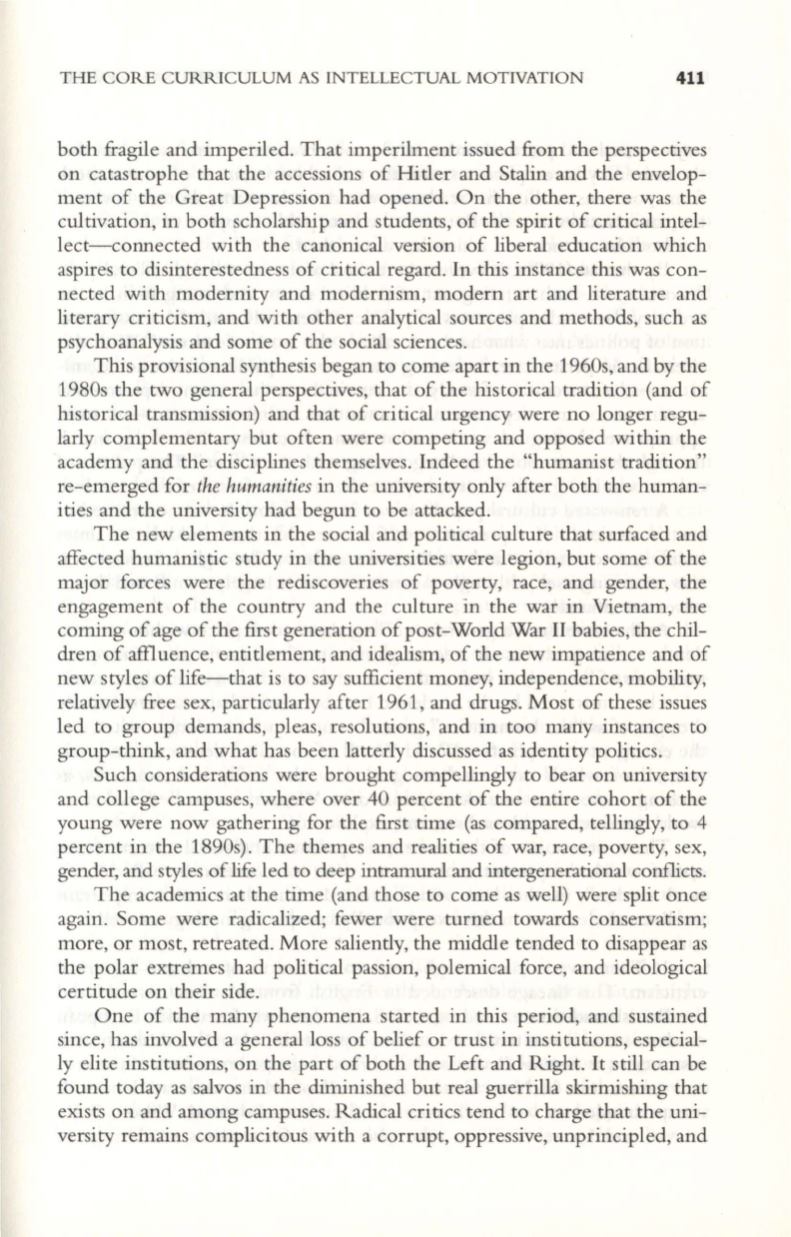
THE CORE CURRICULUM AS INTELLECTUAL MOTrvATION
411
both fragile and imperiled. That imperilment issued from the perspectives
on catastrophe that the accessions of Hitler and Stalin and the envelop–
ment of the Great Depression had opened. On the other, there was the
cultivation, in both scholarship and students, of the spirit of critical intel–
lect-connected with the canonical version of liberal education which
aspires to disinterestedness of critical regard.
In
this instance this was con–
nected with modernity and modernism, modern art and literature and
literary criticism, and with other analytical sources and methods, such as
psychoanalysis and some of the social sciences.
This provisional synthesis began to come apart in the 1960s, and by the
1980s the two general perspectives, that of the historical tradition (and of
historical transmission) and that of critical urgency were no longer regu–
larly complementary but often were competing and opposed within the
academy and the disciplines themselves. Indeed the "humanist tradition"
re-emerged for
the humanities
in the university only after both the human–
ities and the university had begun to be attacked.
The new elements in the social and political culture that surfaced and
affected humanistic study in the universities were legion, but some of the
major forces were the rediscoveries of poverty, race, and gender, the
engagement of the country and the culture ·in the war in Vietnam, the
coming of age of the first generation of post-World War II babies, the chil–
dren of affluence, entitlement, and idealism, of the new impatience and of
new styles of life-that is to say sufficient money, independence, mobility,
relatively free sex, particularly after 1961, and drugs. Most of these issues
led to group demands, pleas, resolutions, and in too many instances to
group-think, and what has been latterly discussed as identity politics.
Such considerations were brought compellingly to bear on university
and college campuses, where over 40 percent of the entire cohort of the
young were now gathering for the first time (as compared, tellingly, to 4
percent in the 1890s). The themes and realities of war, race, poverty, sex,
gender, and styles of life led to deep intramural and intergenerational conflicts.
The academics at the time (and those to come as well) were split once
again. Some were radicalized; fewer were turned towards conservatism;
more, or most, retreated. More saliently, the middle tended to disappear as
the polar extremes had political passion, polemical force, and ideological
certitude on their side.
One of the many phenomena started in this period, and sustained
since, has involved a general loss of belief or trust in institutions, especial–
ly elite institutions, on the part of both the Left and Right.
It
still can be
found today as salvos in the diminished but real guerrilla skirmishing that
exists on and among campuses. Radical critics tend to charge that the uni–
versity remains complicitous with a corrupt, oppressive, unprincipled, and


